NU4220: FGM Prevalence and Safeguarding in African Countries & UK
VerifiedAdded on 2022/09/27
|25
|6618
|19
Report
AI Summary
This report, prepared for the NU4220 course, addresses the critical issue of Female Genital Mutilation (FGM), examining its prevalence in African countries and the United Kingdom, and emphasizing safeguarding and protection measures. The report begins with an introduction to FGM, defining it according to the NHS and WHO, and highlighting its health consequences and cultural contexts. It then explores the prevalence of FGM in various African countries and the UK, providing statistical data and analyzing the underlying factors, including illiteracy, poverty, and cultural beliefs. The report subsequently outlines policy development concerning safeguarding and protection, detailing legal frameworks such as the Prohibition of Female Circumcision Act 1985, the FGM Act 2003, and the Serious Crime Act 2015. It discusses the impact of these legal aspects, including multi-agency guidance, the role of professionals in reporting and preventing FGM, and the legal obligations of teachers and healthcare professionals. The report also examines international and regional efforts to combat FGM, including the roles of the WHO, African Union, and various non-governmental organizations, as well as the Children Act 1989. The conclusion emphasizes the importance of ongoing efforts to eradicate FGM and protect vulnerable populations.
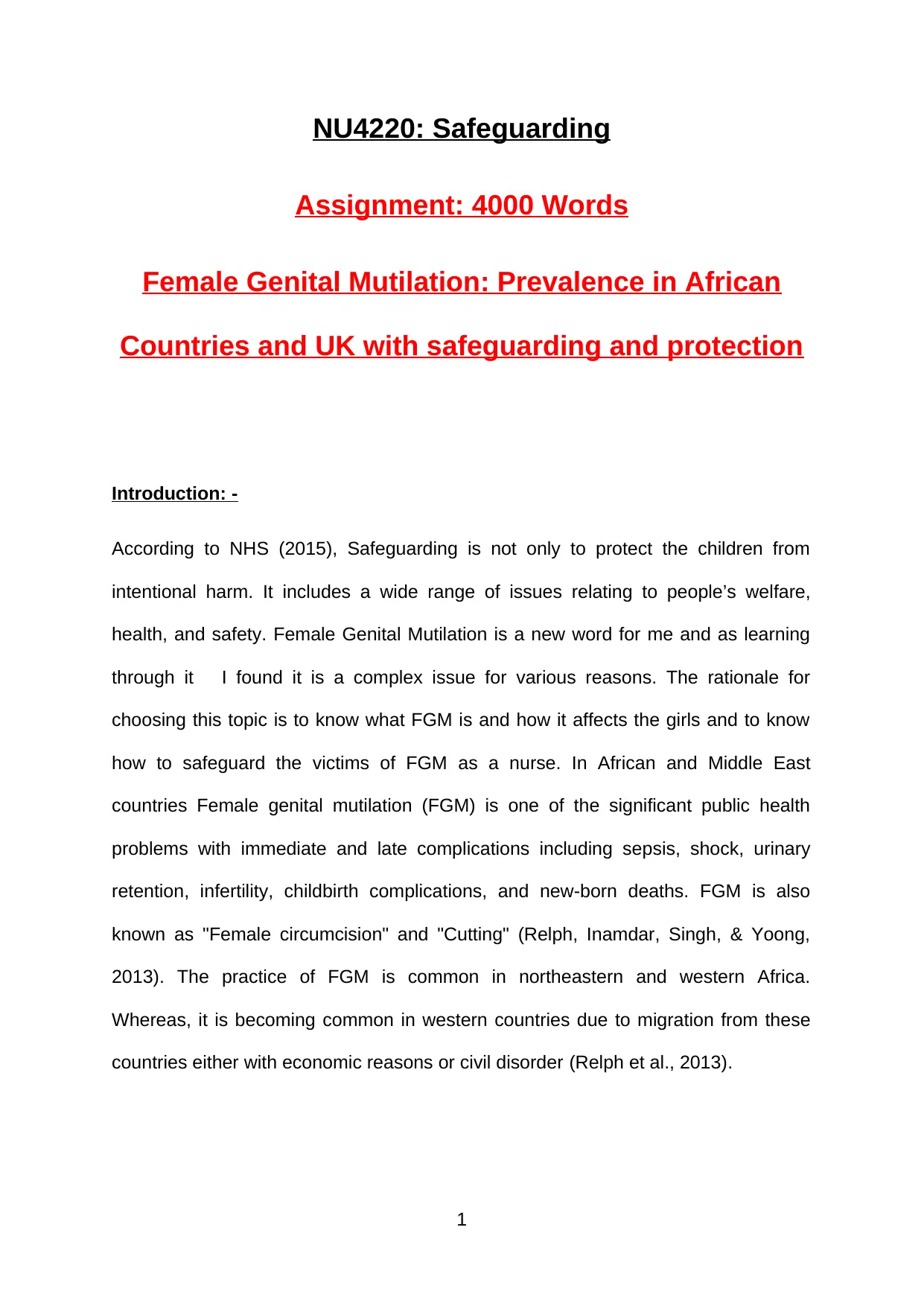
NU4220: Safeguarding
Assignment: 4000 Words
Female Genital Mutilation: Prevalence in African
Countries and UK with safeguarding and protection
Introduction: -
According to NHS (2015), Safeguarding is not only to protect the children from
intentional harm. It includes a wide range of issues relating to people’s welfare,
health, and safety. Female Genital Mutilation is a new word for me and as learning
through it I found it is a complex issue for various reasons. The rationale for
choosing this topic is to know what FGM is and how it affects the girls and to know
how to safeguard the victims of FGM as a nurse. In African and Middle East
countries Female genital mutilation (FGM) is one of the significant public health
problems with immediate and late complications including sepsis, shock, urinary
retention, infertility, childbirth complications, and new-born deaths. FGM is also
known as "Female circumcision" and "Cutting" (Relph, Inamdar, Singh, & Yoong,
2013). The practice of FGM is common in northeastern and western Africa.
Whereas, it is becoming common in western countries due to migration from these
countries either with economic reasons or civil disorder (Relph et al., 2013).
1
Assignment: 4000 Words
Female Genital Mutilation: Prevalence in African
Countries and UK with safeguarding and protection
Introduction: -
According to NHS (2015), Safeguarding is not only to protect the children from
intentional harm. It includes a wide range of issues relating to people’s welfare,
health, and safety. Female Genital Mutilation is a new word for me and as learning
through it I found it is a complex issue for various reasons. The rationale for
choosing this topic is to know what FGM is and how it affects the girls and to know
how to safeguard the victims of FGM as a nurse. In African and Middle East
countries Female genital mutilation (FGM) is one of the significant public health
problems with immediate and late complications including sepsis, shock, urinary
retention, infertility, childbirth complications, and new-born deaths. FGM is also
known as "Female circumcision" and "Cutting" (Relph, Inamdar, Singh, & Yoong,
2013). The practice of FGM is common in northeastern and western Africa.
Whereas, it is becoming common in western countries due to migration from these
countries either with economic reasons or civil disorder (Relph et al., 2013).
1
Paraphrase This Document
Need a fresh take? Get an instant paraphrase of this document with our AI Paraphraser
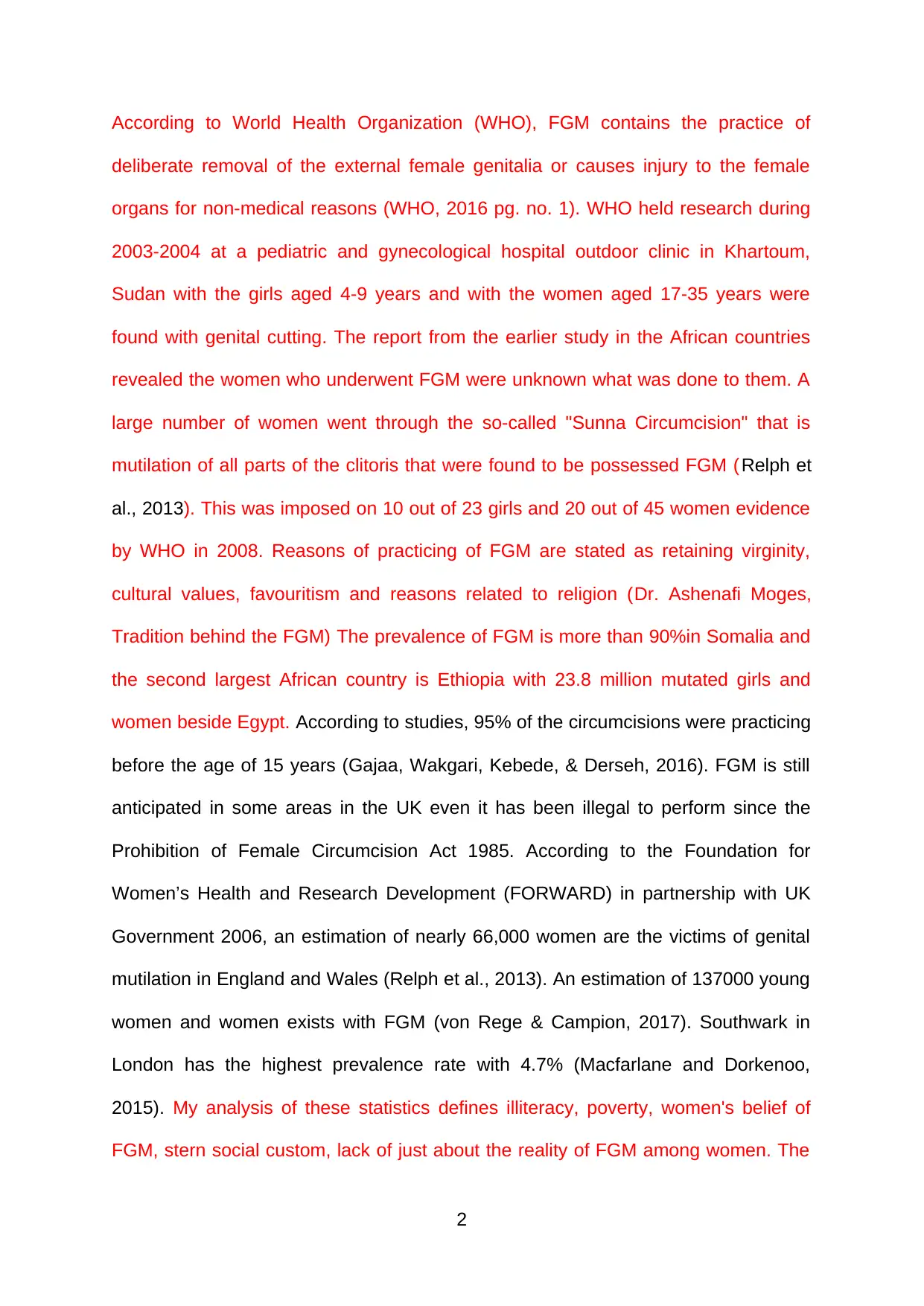
According to World Health Organization (WHO), FGM contains the practice of
deliberate removal of the external female genitalia or causes injury to the female
organs for non-medical reasons (WHO, 2016 pg. no. 1). WHO held research during
2003-2004 at a pediatric and gynecological hospital outdoor clinic in Khartoum,
Sudan with the girls aged 4-9 years and with the women aged 17-35 years were
found with genital cutting. The report from the earlier study in the African countries
revealed the women who underwent FGM were unknown what was done to them. A
large number of women went through the so-called "Sunna Circumcision" that is
mutilation of all parts of the clitoris that were found to be possessed FGM ( Relph et
al., 2013). This was imposed on 10 out of 23 girls and 20 out of 45 women evidence
by WHO in 2008. Reasons of practicing of FGM are stated as retaining virginity,
cultural values, favouritism and reasons related to religion (Dr. Ashenafi Moges,
Tradition behind the FGM) The prevalence of FGM is more than 90%in Somalia and
the second largest African country is Ethiopia with 23.8 million mutated girls and
women beside Egypt. According to studies, 95% of the circumcisions were practicing
before the age of 15 years (Gajaa, Wakgari, Kebede, & Derseh, 2016). FGM is still
anticipated in some areas in the UK even it has been illegal to perform since the
Prohibition of Female Circumcision Act 1985. According to the Foundation for
Women’s Health and Research Development (FORWARD) in partnership with UK
Government 2006, an estimation of nearly 66,000 women are the victims of genital
mutilation in England and Wales (Relph et al., 2013). An estimation of 137000 young
women and women exists with FGM (von Rege & Campion, 2017). Southwark in
London has the highest prevalence rate with 4.7% (Macfarlane and Dorkenoo,
2015). My analysis of these statistics defines illiteracy, poverty, women's belief of
FGM, stern social custom, lack of just about the reality of FGM among women. The
2
deliberate removal of the external female genitalia or causes injury to the female
organs for non-medical reasons (WHO, 2016 pg. no. 1). WHO held research during
2003-2004 at a pediatric and gynecological hospital outdoor clinic in Khartoum,
Sudan with the girls aged 4-9 years and with the women aged 17-35 years were
found with genital cutting. The report from the earlier study in the African countries
revealed the women who underwent FGM were unknown what was done to them. A
large number of women went through the so-called "Sunna Circumcision" that is
mutilation of all parts of the clitoris that were found to be possessed FGM ( Relph et
al., 2013). This was imposed on 10 out of 23 girls and 20 out of 45 women evidence
by WHO in 2008. Reasons of practicing of FGM are stated as retaining virginity,
cultural values, favouritism and reasons related to religion (Dr. Ashenafi Moges,
Tradition behind the FGM) The prevalence of FGM is more than 90%in Somalia and
the second largest African country is Ethiopia with 23.8 million mutated girls and
women beside Egypt. According to studies, 95% of the circumcisions were practicing
before the age of 15 years (Gajaa, Wakgari, Kebede, & Derseh, 2016). FGM is still
anticipated in some areas in the UK even it has been illegal to perform since the
Prohibition of Female Circumcision Act 1985. According to the Foundation for
Women’s Health and Research Development (FORWARD) in partnership with UK
Government 2006, an estimation of nearly 66,000 women are the victims of genital
mutilation in England and Wales (Relph et al., 2013). An estimation of 137000 young
women and women exists with FGM (von Rege & Campion, 2017). Southwark in
London has the highest prevalence rate with 4.7% (Macfarlane and Dorkenoo,
2015). My analysis of these statistics defines illiteracy, poverty, women's belief of
FGM, stern social custom, lack of just about the reality of FGM among women. The
2
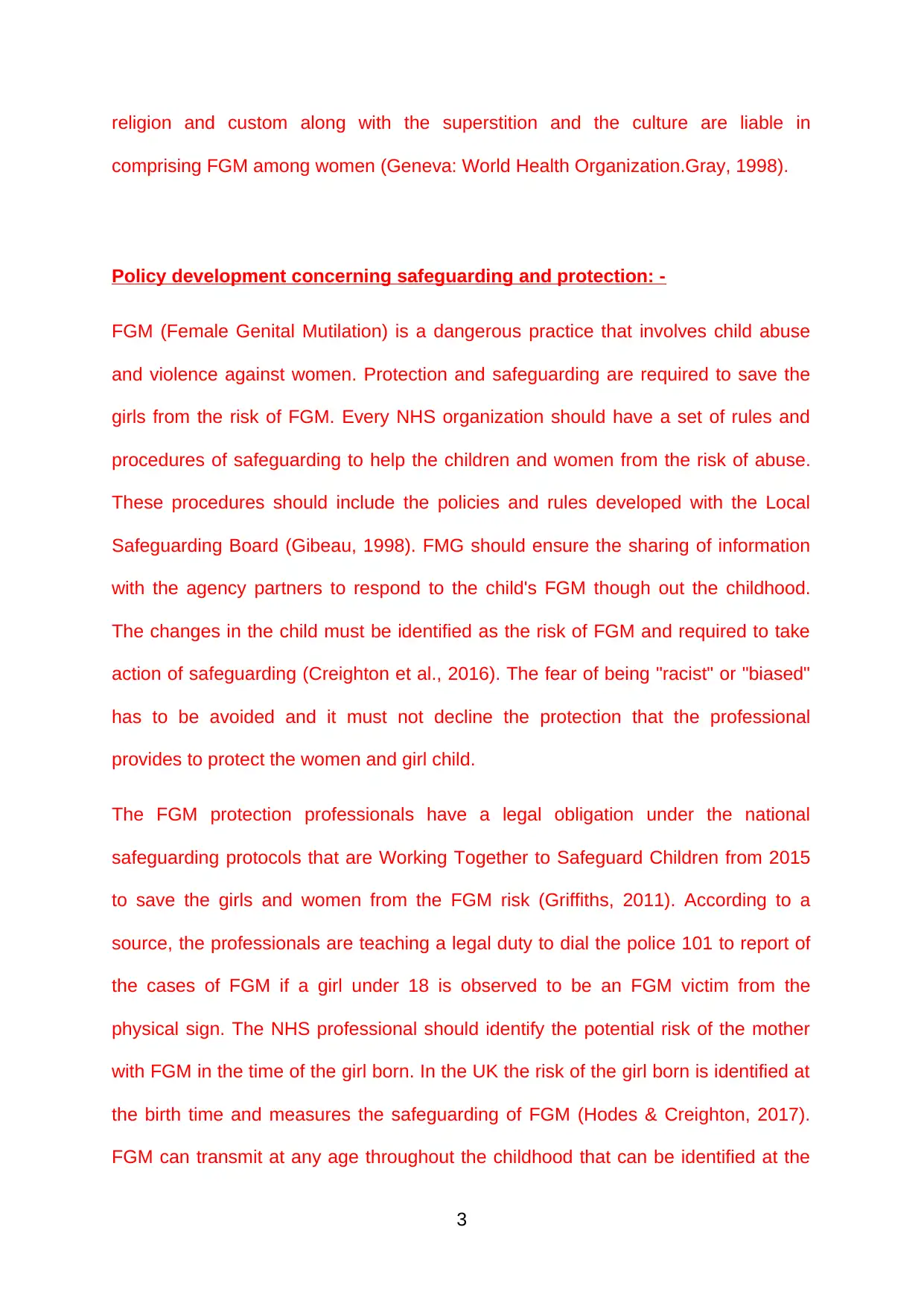
religion and custom along with the superstition and the culture are liable in
comprising FGM among women (Geneva: World Health Organization.Gray, 1998).
Policy development concerning safeguarding and protection: -
FGM (Female Genital Mutilation) is a dangerous practice that involves child abuse
and violence against women. Protection and safeguarding are required to save the
girls from the risk of FGM. Every NHS organization should have a set of rules and
procedures of safeguarding to help the children and women from the risk of abuse.
These procedures should include the policies and rules developed with the Local
Safeguarding Board (Gibeau, 1998). FMG should ensure the sharing of information
with the agency partners to respond to the child's FGM though out the childhood.
The changes in the child must be identified as the risk of FGM and required to take
action of safeguarding (Creighton et al., 2016). The fear of being "racist" or "biased"
has to be avoided and it must not decline the protection that the professional
provides to protect the women and girl child.
The FGM protection professionals have a legal obligation under the national
safeguarding protocols that are Working Together to Safeguard Children from 2015
to save the girls and women from the FGM risk (Griffiths, 2011). According to a
source, the professionals are teaching a legal duty to dial the police 101 to report of
the cases of FGM if a girl under 18 is observed to be an FGM victim from the
physical sign. The NHS professional should identify the potential risk of the mother
with FGM in the time of the girl born. In the UK the risk of the girl born is identified at
the birth time and measures the safeguarding of FGM (Hodes & Creighton, 2017).
FGM can transmit at any age throughout the childhood that can be identified at the
3
comprising FGM among women (Geneva: World Health Organization.Gray, 1998).
Policy development concerning safeguarding and protection: -
FGM (Female Genital Mutilation) is a dangerous practice that involves child abuse
and violence against women. Protection and safeguarding are required to save the
girls from the risk of FGM. Every NHS organization should have a set of rules and
procedures of safeguarding to help the children and women from the risk of abuse.
These procedures should include the policies and rules developed with the Local
Safeguarding Board (Gibeau, 1998). FMG should ensure the sharing of information
with the agency partners to respond to the child's FGM though out the childhood.
The changes in the child must be identified as the risk of FGM and required to take
action of safeguarding (Creighton et al., 2016). The fear of being "racist" or "biased"
has to be avoided and it must not decline the protection that the professional
provides to protect the women and girl child.
The FGM protection professionals have a legal obligation under the national
safeguarding protocols that are Working Together to Safeguard Children from 2015
to save the girls and women from the FGM risk (Griffiths, 2011). According to a
source, the professionals are teaching a legal duty to dial the police 101 to report of
the cases of FGM if a girl under 18 is observed to be an FGM victim from the
physical sign. The NHS professional should identify the potential risk of the mother
with FGM in the time of the girl born. In the UK the risk of the girl born is identified at
the birth time and measures the safeguarding of FGM (Hodes & Creighton, 2017).
FGM can transmit at any age throughout the childhood that can be identified at the
3
⊘ This is a preview!⊘
Do you want full access?
Subscribe today to unlock all pages.

Trusted by 1+ million students worldwide
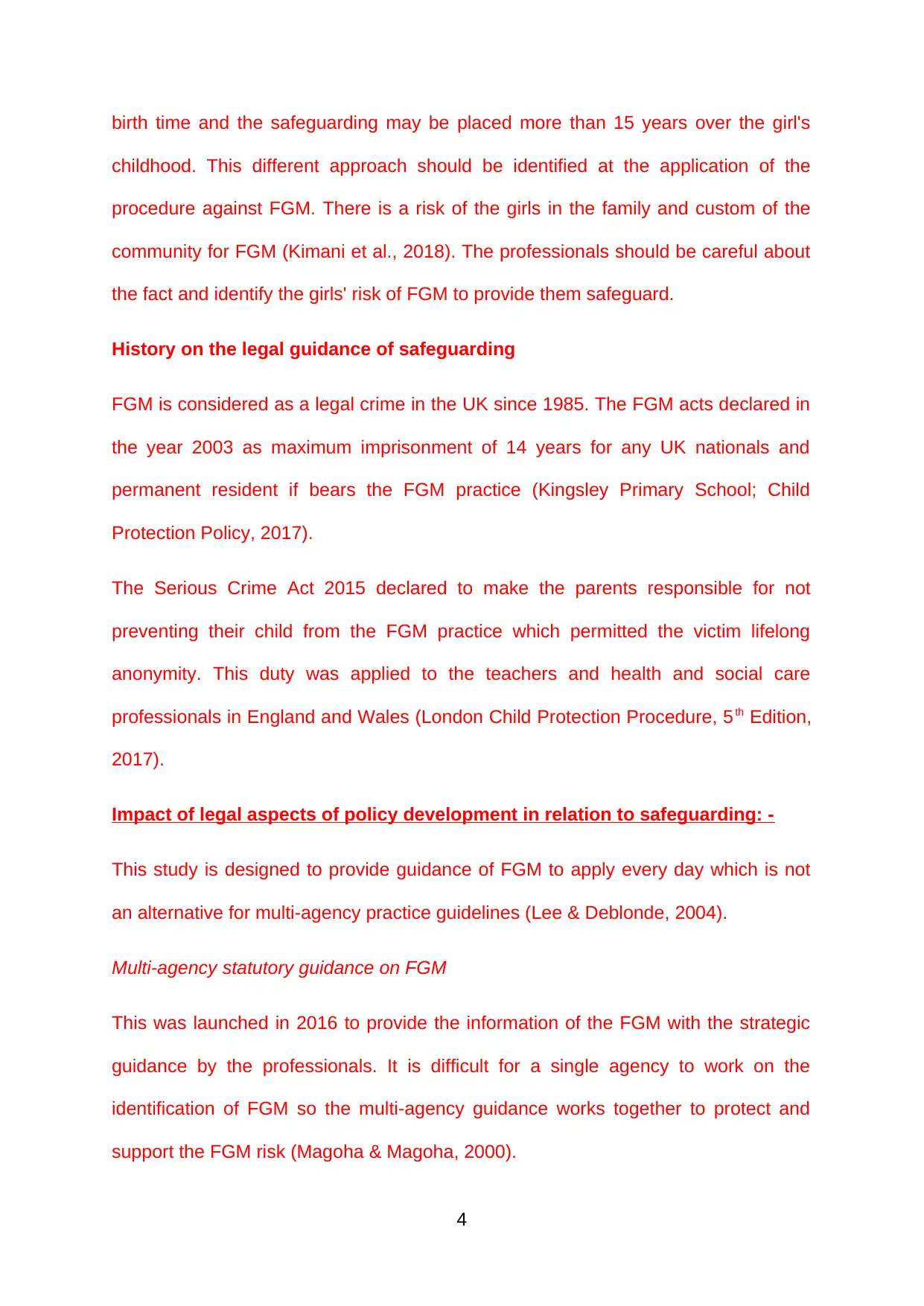
birth time and the safeguarding may be placed more than 15 years over the girl's
childhood. This different approach should be identified at the application of the
procedure against FGM. There is a risk of the girls in the family and custom of the
community for FGM (Kimani et al., 2018). The professionals should be careful about
the fact and identify the girls' risk of FGM to provide them safeguard.
History on the legal guidance of safeguarding
FGM is considered as a legal crime in the UK since 1985. The FGM acts declared in
the year 2003 as maximum imprisonment of 14 years for any UK nationals and
permanent resident if bears the FGM practice (Kingsley Primary School; Child
Protection Policy, 2017).
The Serious Crime Act 2015 declared to make the parents responsible for not
preventing their child from the FGM practice which permitted the victim lifelong
anonymity. This duty was applied to the teachers and health and social care
professionals in England and Wales (London Child Protection Procedure, 5th Edition,
2017).
Impact of legal aspects of policy development in relation to safeguarding: -
This study is designed to provide guidance of FGM to apply every day which is not
an alternative for multi-agency practice guidelines (Lee & Deblonde, 2004).
Multi-agency statutory guidance on FGM
This was launched in 2016 to provide the information of the FGM with the strategic
guidance by the professionals. It is difficult for a single agency to work on the
identification of FGM so the multi-agency guidance works together to protect and
support the FGM risk (Magoha & Magoha, 2000).
4
childhood. This different approach should be identified at the application of the
procedure against FGM. There is a risk of the girls in the family and custom of the
community for FGM (Kimani et al., 2018). The professionals should be careful about
the fact and identify the girls' risk of FGM to provide them safeguard.
History on the legal guidance of safeguarding
FGM is considered as a legal crime in the UK since 1985. The FGM acts declared in
the year 2003 as maximum imprisonment of 14 years for any UK nationals and
permanent resident if bears the FGM practice (Kingsley Primary School; Child
Protection Policy, 2017).
The Serious Crime Act 2015 declared to make the parents responsible for not
preventing their child from the FGM practice which permitted the victim lifelong
anonymity. This duty was applied to the teachers and health and social care
professionals in England and Wales (London Child Protection Procedure, 5th Edition,
2017).
Impact of legal aspects of policy development in relation to safeguarding: -
This study is designed to provide guidance of FGM to apply every day which is not
an alternative for multi-agency practice guidelines (Lee & Deblonde, 2004).
Multi-agency statutory guidance on FGM
This was launched in 2016 to provide the information of the FGM with the strategic
guidance by the professionals. It is difficult for a single agency to work on the
identification of FGM so the multi-agency guidance works together to protect and
support the FGM risk (Magoha & Magoha, 2000).
4
Paraphrase This Document
Need a fresh take? Get an instant paraphrase of this document with our AI Paraphraser
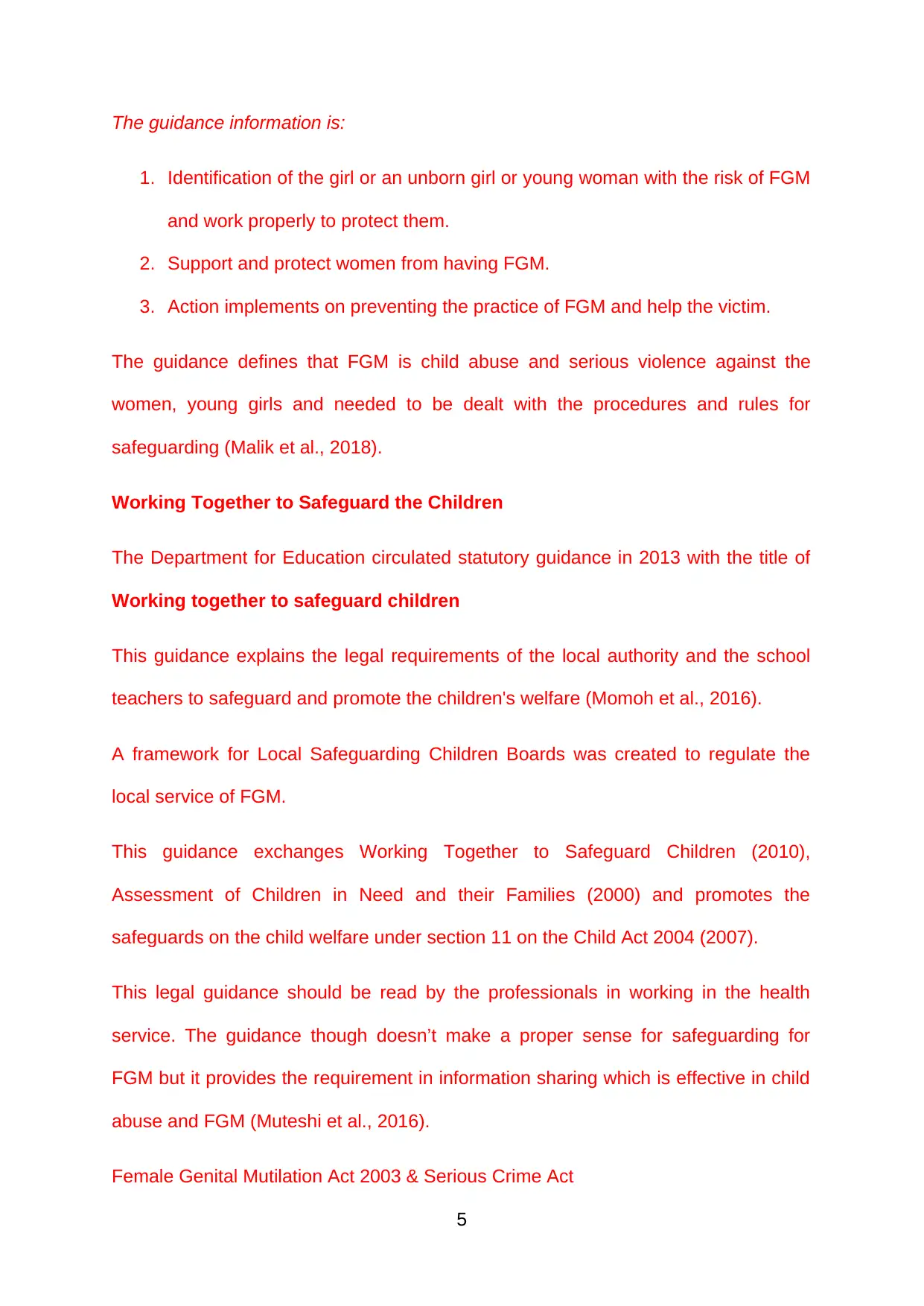
The guidance information is:
1. Identification of the girl or an unborn girl or young woman with the risk of FGM
and work properly to protect them.
2. Support and protect women from having FGM.
3. Action implements on preventing the practice of FGM and help the victim.
The guidance defines that FGM is child abuse and serious violence against the
women, young girls and needed to be dealt with the procedures and rules for
safeguarding (Malik et al., 2018).
Working Together to Safeguard the Children
The Department for Education circulated statutory guidance in 2013 with the title of
Working together to safeguard children
This guidance explains the legal requirements of the local authority and the school
teachers to safeguard and promote the children's welfare (Momoh et al., 2016).
A framework for Local Safeguarding Children Boards was created to regulate the
local service of FGM.
This guidance exchanges Working Together to Safeguard Children (2010),
Assessment of Children in Need and their Families (2000) and promotes the
safeguards on the child welfare under section 11 on the Child Act 2004 (2007).
This legal guidance should be read by the professionals in working in the health
service. The guidance though doesn’t make a proper sense for safeguarding for
FGM but it provides the requirement in information sharing which is effective in child
abuse and FGM (Muteshi et al., 2016).
Female Genital Mutilation Act 2003 & Serious Crime Act
5
1. Identification of the girl or an unborn girl or young woman with the risk of FGM
and work properly to protect them.
2. Support and protect women from having FGM.
3. Action implements on preventing the practice of FGM and help the victim.
The guidance defines that FGM is child abuse and serious violence against the
women, young girls and needed to be dealt with the procedures and rules for
safeguarding (Malik et al., 2018).
Working Together to Safeguard the Children
The Department for Education circulated statutory guidance in 2013 with the title of
Working together to safeguard children
This guidance explains the legal requirements of the local authority and the school
teachers to safeguard and promote the children's welfare (Momoh et al., 2016).
A framework for Local Safeguarding Children Boards was created to regulate the
local service of FGM.
This guidance exchanges Working Together to Safeguard Children (2010),
Assessment of Children in Need and their Families (2000) and promotes the
safeguards on the child welfare under section 11 on the Child Act 2004 (2007).
This legal guidance should be read by the professionals in working in the health
service. The guidance though doesn’t make a proper sense for safeguarding for
FGM but it provides the requirement in information sharing which is effective in child
abuse and FGM (Muteshi et al., 2016).
Female Genital Mutilation Act 2003 & Serious Crime Act
5
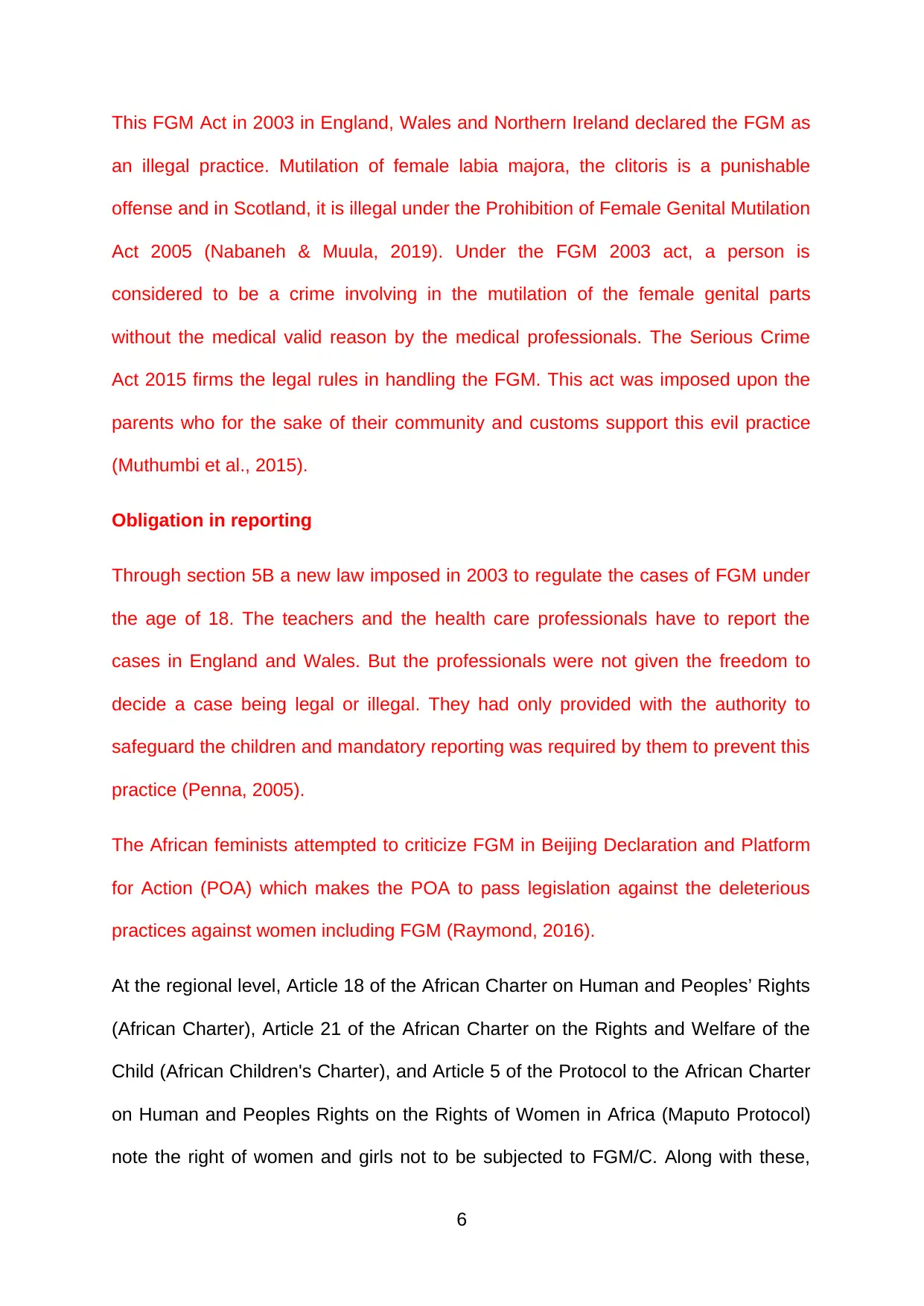
This FGM Act in 2003 in England, Wales and Northern Ireland declared the FGM as
an illegal practice. Mutilation of female labia majora, the clitoris is a punishable
offense and in Scotland, it is illegal under the Prohibition of Female Genital Mutilation
Act 2005 (Nabaneh & Muula, 2019). Under the FGM 2003 act, a person is
considered to be a crime involving in the mutilation of the female genital parts
without the medical valid reason by the medical professionals. The Serious Crime
Act 2015 firms the legal rules in handling the FGM. This act was imposed upon the
parents who for the sake of their community and customs support this evil practice
(Muthumbi et al., 2015).
Obligation in reporting
Through section 5B a new law imposed in 2003 to regulate the cases of FGM under
the age of 18. The teachers and the health care professionals have to report the
cases in England and Wales. But the professionals were not given the freedom to
decide a case being legal or illegal. They had only provided with the authority to
safeguard the children and mandatory reporting was required by them to prevent this
practice (Penna, 2005).
The African feminists attempted to criticize FGM in Beijing Declaration and Platform
for Action (POA) which makes the POA to pass legislation against the deleterious
practices against women including FGM (Raymond, 2016).
At the regional level, Article 18 of the African Charter on Human and Peoples’ Rights
(African Charter), Article 21 of the African Charter on the Rights and Welfare of the
Child (African Children's Charter), and Article 5 of the Protocol to the African Charter
on Human and Peoples Rights on the Rights of Women in Africa (Maputo Protocol)
note the right of women and girls not to be subjected to FGM/C. Along with these,
6
an illegal practice. Mutilation of female labia majora, the clitoris is a punishable
offense and in Scotland, it is illegal under the Prohibition of Female Genital Mutilation
Act 2005 (Nabaneh & Muula, 2019). Under the FGM 2003 act, a person is
considered to be a crime involving in the mutilation of the female genital parts
without the medical valid reason by the medical professionals. The Serious Crime
Act 2015 firms the legal rules in handling the FGM. This act was imposed upon the
parents who for the sake of their community and customs support this evil practice
(Muthumbi et al., 2015).
Obligation in reporting
Through section 5B a new law imposed in 2003 to regulate the cases of FGM under
the age of 18. The teachers and the health care professionals have to report the
cases in England and Wales. But the professionals were not given the freedom to
decide a case being legal or illegal. They had only provided with the authority to
safeguard the children and mandatory reporting was required by them to prevent this
practice (Penna, 2005).
The African feminists attempted to criticize FGM in Beijing Declaration and Platform
for Action (POA) which makes the POA to pass legislation against the deleterious
practices against women including FGM (Raymond, 2016).
At the regional level, Article 18 of the African Charter on Human and Peoples’ Rights
(African Charter), Article 21 of the African Charter on the Rights and Welfare of the
Child (African Children's Charter), and Article 5 of the Protocol to the African Charter
on Human and Peoples Rights on the Rights of Women in Africa (Maputo Protocol)
note the right of women and girls not to be subjected to FGM/C. Along with these,
6
⊘ This is a preview!⊘
Do you want full access?
Subscribe today to unlock all pages.

Trusted by 1+ million students worldwide
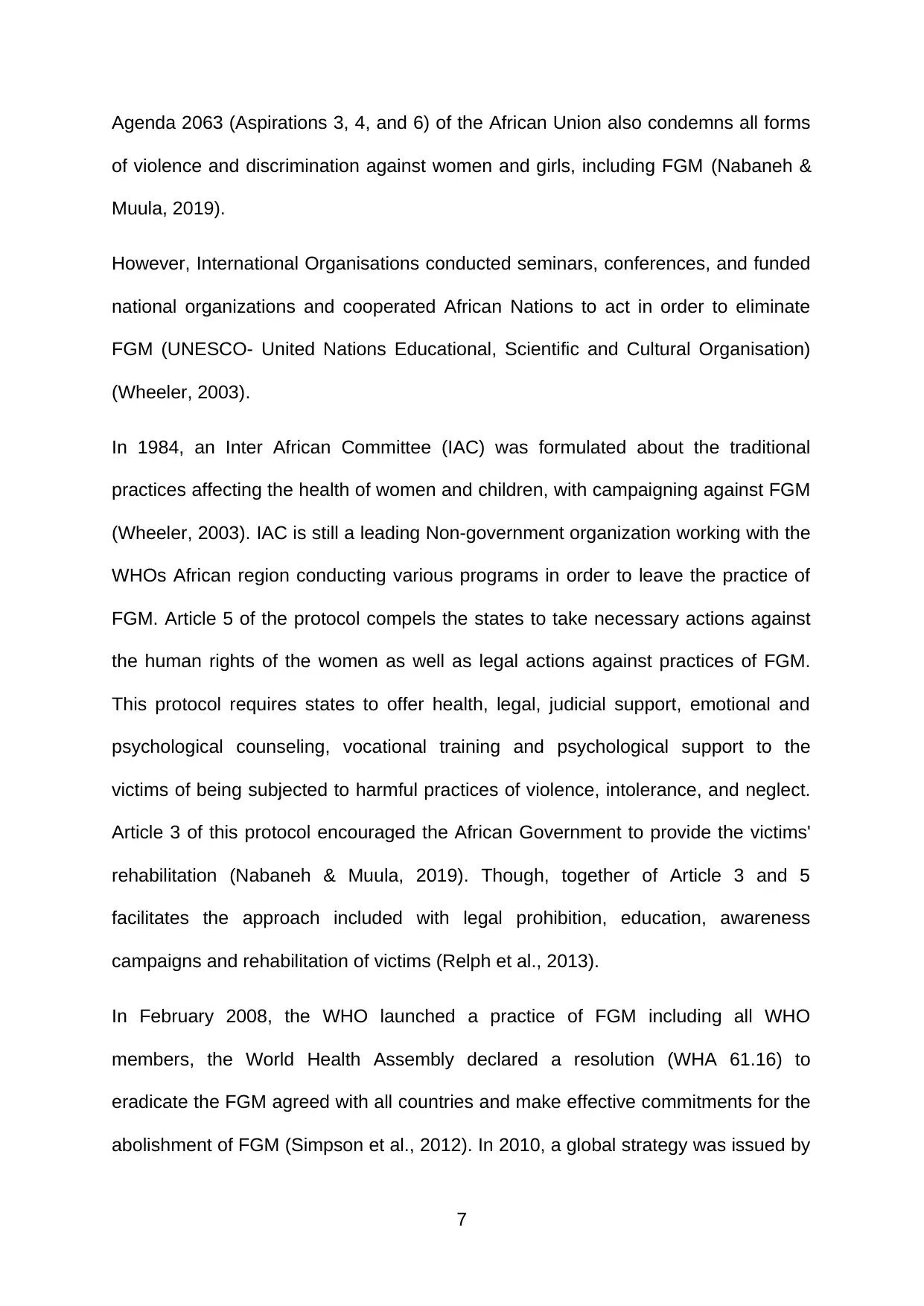
Agenda 2063 (Aspirations 3, 4, and 6) of the African Union also condemns all forms
of violence and discrimination against women and girls, including FGM (Nabaneh &
Muula, 2019).
However, International Organisations conducted seminars, conferences, and funded
national organizations and cooperated African Nations to act in order to eliminate
FGM (UNESCO- United Nations Educational, Scientific and Cultural Organisation)
(Wheeler, 2003).
In 1984, an Inter African Committee (IAC) was formulated about the traditional
practices affecting the health of women and children, with campaigning against FGM
(Wheeler, 2003). IAC is still a leading Non-government organization working with the
WHOs African region conducting various programs in order to leave the practice of
FGM. Article 5 of the protocol compels the states to take necessary actions against
the human rights of the women as well as legal actions against practices of FGM.
This protocol requires states to offer health, legal, judicial support, emotional and
psychological counseling, vocational training and psychological support to the
victims of being subjected to harmful practices of violence, intolerance, and neglect.
Article 3 of this protocol encouraged the African Government to provide the victims'
rehabilitation (Nabaneh & Muula, 2019). Though, together of Article 3 and 5
facilitates the approach included with legal prohibition, education, awareness
campaigns and rehabilitation of victims (Relph et al., 2013).
In February 2008, the WHO launched a practice of FGM including all WHO
members, the World Health Assembly declared a resolution (WHA 61.16) to
eradicate the FGM agreed with all countries and make effective commitments for the
abolishment of FGM (Simpson et al., 2012). In 2010, a global strategy was issued by
7
of violence and discrimination against women and girls, including FGM (Nabaneh &
Muula, 2019).
However, International Organisations conducted seminars, conferences, and funded
national organizations and cooperated African Nations to act in order to eliminate
FGM (UNESCO- United Nations Educational, Scientific and Cultural Organisation)
(Wheeler, 2003).
In 1984, an Inter African Committee (IAC) was formulated about the traditional
practices affecting the health of women and children, with campaigning against FGM
(Wheeler, 2003). IAC is still a leading Non-government organization working with the
WHOs African region conducting various programs in order to leave the practice of
FGM. Article 5 of the protocol compels the states to take necessary actions against
the human rights of the women as well as legal actions against practices of FGM.
This protocol requires states to offer health, legal, judicial support, emotional and
psychological counseling, vocational training and psychological support to the
victims of being subjected to harmful practices of violence, intolerance, and neglect.
Article 3 of this protocol encouraged the African Government to provide the victims'
rehabilitation (Nabaneh & Muula, 2019). Though, together of Article 3 and 5
facilitates the approach included with legal prohibition, education, awareness
campaigns and rehabilitation of victims (Relph et al., 2013).
In February 2008, the WHO launched a practice of FGM including all WHO
members, the World Health Assembly declared a resolution (WHA 61.16) to
eradicate the FGM agreed with all countries and make effective commitments for the
abolishment of FGM (Simpson et al., 2012). In 2010, a global strategy was issued by
7
Paraphrase This Document
Need a fresh take? Get an instant paraphrase of this document with our AI Paraphraser
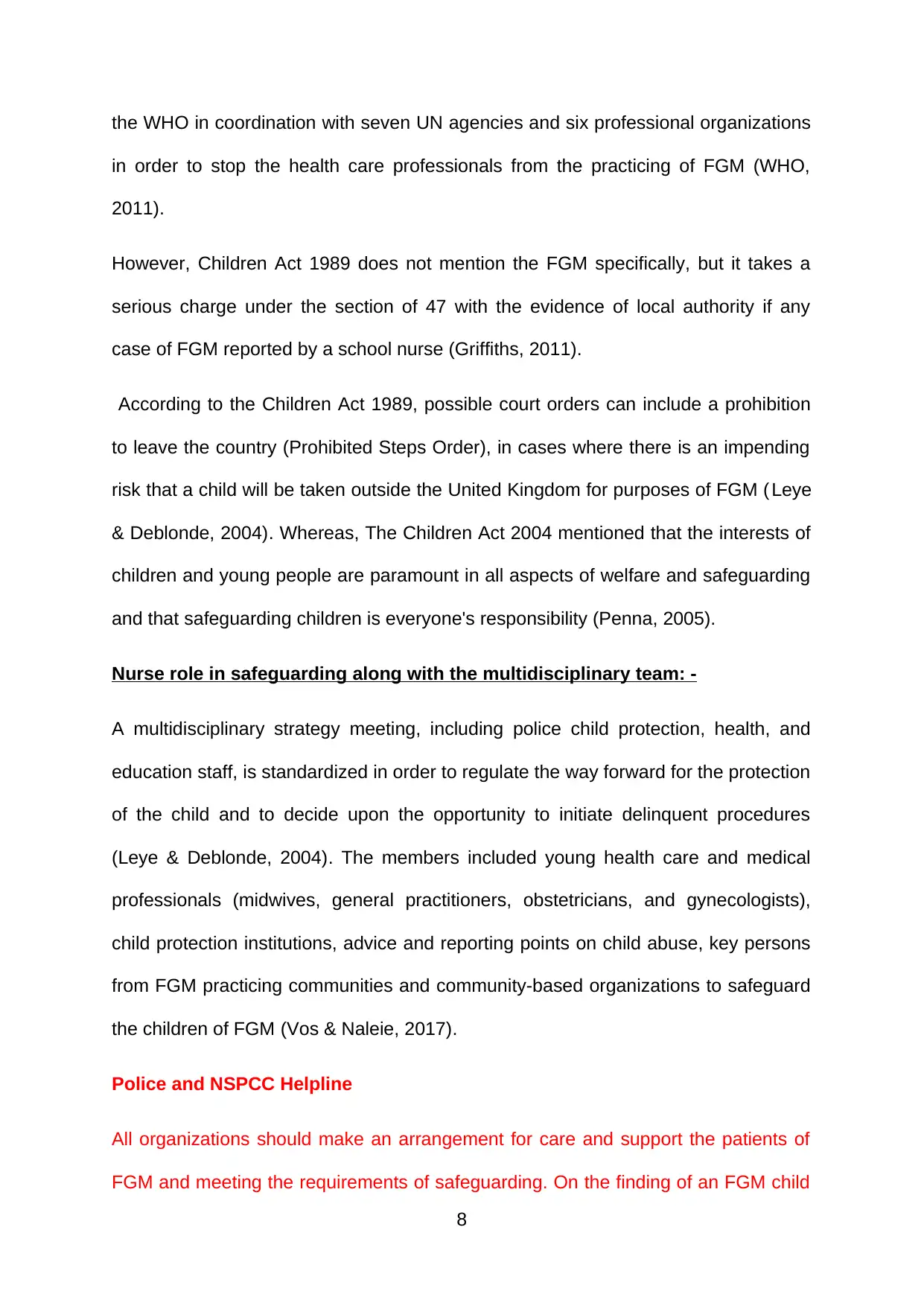
the WHO in coordination with seven UN agencies and six professional organizations
in order to stop the health care professionals from the practicing of FGM (WHO,
2011).
However, Children Act 1989 does not mention the FGM specifically, but it takes a
serious charge under the section of 47 with the evidence of local authority if any
case of FGM reported by a school nurse (Griffiths, 2011).
According to the Children Act 1989, possible court orders can include a prohibition
to leave the country (Prohibited Steps Order), in cases where there is an impending
risk that a child will be taken outside the United Kingdom for purposes of FGM ( Leye
& Deblonde, 2004). Whereas, The Children Act 2004 mentioned that the interests of
children and young people are paramount in all aspects of welfare and safeguarding
and that safeguarding children is everyone's responsibility (Penna, 2005).
Nurse role in safeguarding along with the multidisciplinary team: -
A multidisciplinary strategy meeting, including police child protection, health, and
education staff, is standardized in order to regulate the way forward for the protection
of the child and to decide upon the opportunity to initiate delinquent procedures
(Leye & Deblonde, 2004). The members included young health care and medical
professionals (midwives, general practitioners, obstetricians, and gynecologists),
child protection institutions, advice and reporting points on child abuse, key persons
from FGM practicing communities and community-based organizations to safeguard
the children of FGM (Vos & Naleie, 2017).
Police and NSPCC Helpline
All organizations should make an arrangement for care and support the patients of
FGM and meeting the requirements of safeguarding. On the finding of an FGM child
8
in order to stop the health care professionals from the practicing of FGM (WHO,
2011).
However, Children Act 1989 does not mention the FGM specifically, but it takes a
serious charge under the section of 47 with the evidence of local authority if any
case of FGM reported by a school nurse (Griffiths, 2011).
According to the Children Act 1989, possible court orders can include a prohibition
to leave the country (Prohibited Steps Order), in cases where there is an impending
risk that a child will be taken outside the United Kingdom for purposes of FGM ( Leye
& Deblonde, 2004). Whereas, The Children Act 2004 mentioned that the interests of
children and young people are paramount in all aspects of welfare and safeguarding
and that safeguarding children is everyone's responsibility (Penna, 2005).
Nurse role in safeguarding along with the multidisciplinary team: -
A multidisciplinary strategy meeting, including police child protection, health, and
education staff, is standardized in order to regulate the way forward for the protection
of the child and to decide upon the opportunity to initiate delinquent procedures
(Leye & Deblonde, 2004). The members included young health care and medical
professionals (midwives, general practitioners, obstetricians, and gynecologists),
child protection institutions, advice and reporting points on child abuse, key persons
from FGM practicing communities and community-based organizations to safeguard
the children of FGM (Vos & Naleie, 2017).
Police and NSPCC Helpline
All organizations should make an arrangement for care and support the patients of
FGM and meeting the requirements of safeguarding. On the finding of an FGM child
8
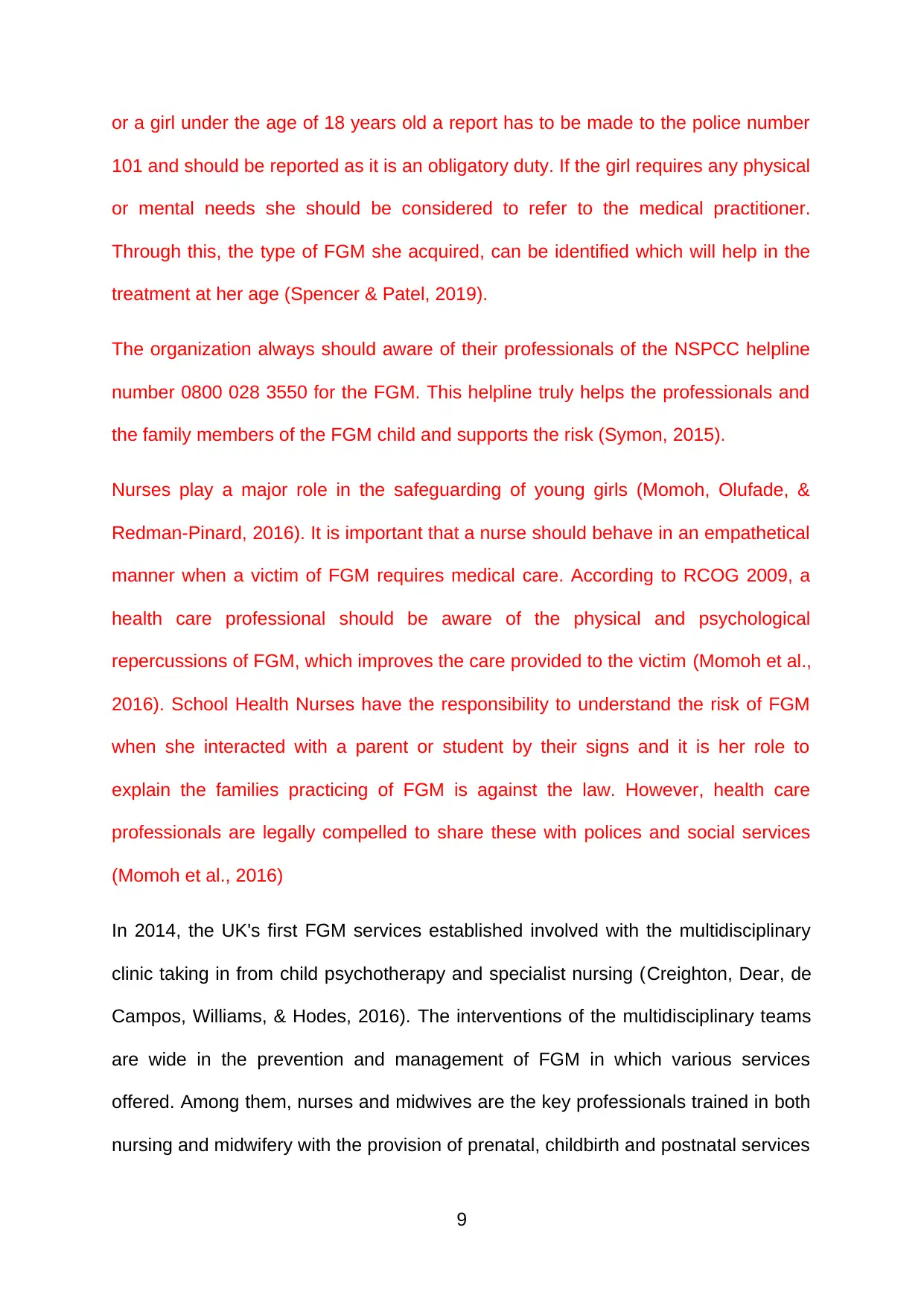
or a girl under the age of 18 years old a report has to be made to the police number
101 and should be reported as it is an obligatory duty. If the girl requires any physical
or mental needs she should be considered to refer to the medical practitioner.
Through this, the type of FGM she acquired, can be identified which will help in the
treatment at her age (Spencer & Patel, 2019).
The organization always should aware of their professionals of the NSPCC helpline
number 0800 028 3550 for the FGM. This helpline truly helps the professionals and
the family members of the FGM child and supports the risk (Symon, 2015).
Nurses play a major role in the safeguarding of young girls (Momoh, Olufade, &
Redman-Pinard, 2016). It is important that a nurse should behave in an empathetical
manner when a victim of FGM requires medical care. According to RCOG 2009, a
health care professional should be aware of the physical and psychological
repercussions of FGM, which improves the care provided to the victim (Momoh et al.,
2016). School Health Nurses have the responsibility to understand the risk of FGM
when she interacted with a parent or student by their signs and it is her role to
explain the families practicing of FGM is against the law. However, health care
professionals are legally compelled to share these with polices and social services
(Momoh et al., 2016)
In 2014, the UK's first FGM services established involved with the multidisciplinary
clinic taking in from child psychotherapy and specialist nursing (Creighton, Dear, de
Campos, Williams, & Hodes, 2016). The interventions of the multidisciplinary teams
are wide in the prevention and management of FGM in which various services
offered. Among them, nurses and midwives are the key professionals trained in both
nursing and midwifery with the provision of prenatal, childbirth and postnatal services
9
101 and should be reported as it is an obligatory duty. If the girl requires any physical
or mental needs she should be considered to refer to the medical practitioner.
Through this, the type of FGM she acquired, can be identified which will help in the
treatment at her age (Spencer & Patel, 2019).
The organization always should aware of their professionals of the NSPCC helpline
number 0800 028 3550 for the FGM. This helpline truly helps the professionals and
the family members of the FGM child and supports the risk (Symon, 2015).
Nurses play a major role in the safeguarding of young girls (Momoh, Olufade, &
Redman-Pinard, 2016). It is important that a nurse should behave in an empathetical
manner when a victim of FGM requires medical care. According to RCOG 2009, a
health care professional should be aware of the physical and psychological
repercussions of FGM, which improves the care provided to the victim (Momoh et al.,
2016). School Health Nurses have the responsibility to understand the risk of FGM
when she interacted with a parent or student by their signs and it is her role to
explain the families practicing of FGM is against the law. However, health care
professionals are legally compelled to share these with polices and social services
(Momoh et al., 2016)
In 2014, the UK's first FGM services established involved with the multidisciplinary
clinic taking in from child psychotherapy and specialist nursing (Creighton, Dear, de
Campos, Williams, & Hodes, 2016). The interventions of the multidisciplinary teams
are wide in the prevention and management of FGM in which various services
offered. Among them, nurses and midwives are the key professionals trained in both
nursing and midwifery with the provision of prenatal, childbirth and postnatal services
9
⊘ This is a preview!⊘
Do you want full access?
Subscribe today to unlock all pages.

Trusted by 1+ million students worldwide
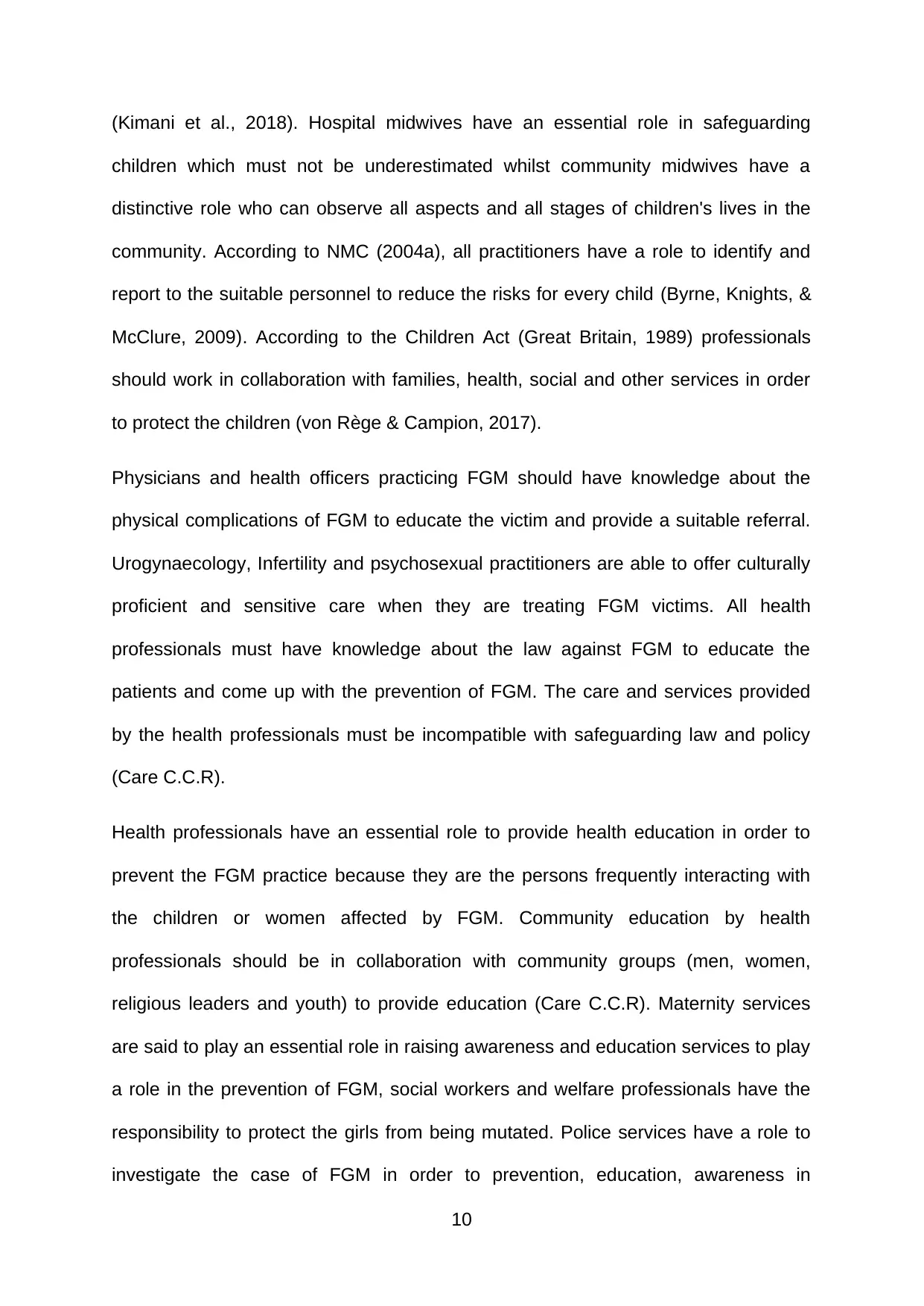
(Kimani et al., 2018). Hospital midwives have an essential role in safeguarding
children which must not be underestimated whilst community midwives have a
distinctive role who can observe all aspects and all stages of children's lives in the
community. According to NMC (2004a), all practitioners have a role to identify and
report to the suitable personnel to reduce the risks for every child (Byrne, Knights, &
McClure, 2009). According to the Children Act (Great Britain, 1989) professionals
should work in collaboration with families, health, social and other services in order
to protect the children (von Rège & Campion, 2017).
Physicians and health officers practicing FGM should have knowledge about the
physical complications of FGM to educate the victim and provide a suitable referral.
Urogynaecology, Infertility and psychosexual practitioners are able to offer culturally
proficient and sensitive care when they are treating FGM victims. All health
professionals must have knowledge about the law against FGM to educate the
patients and come up with the prevention of FGM. The care and services provided
by the health professionals must be incompatible with safeguarding law and policy
(Care C.C.R).
Health professionals have an essential role to provide health education in order to
prevent the FGM practice because they are the persons frequently interacting with
the children or women affected by FGM. Community education by health
professionals should be in collaboration with community groups (men, women,
religious leaders and youth) to provide education (Care C.C.R). Maternity services
are said to play an essential role in raising awareness and education services to play
a role in the prevention of FGM, social workers and welfare professionals have the
responsibility to protect the girls from being mutated. Police services have a role to
investigate the case of FGM in order to prevention, education, awareness in
10
children which must not be underestimated whilst community midwives have a
distinctive role who can observe all aspects and all stages of children's lives in the
community. According to NMC (2004a), all practitioners have a role to identify and
report to the suitable personnel to reduce the risks for every child (Byrne, Knights, &
McClure, 2009). According to the Children Act (Great Britain, 1989) professionals
should work in collaboration with families, health, social and other services in order
to protect the children (von Rège & Campion, 2017).
Physicians and health officers practicing FGM should have knowledge about the
physical complications of FGM to educate the victim and provide a suitable referral.
Urogynaecology, Infertility and psychosexual practitioners are able to offer culturally
proficient and sensitive care when they are treating FGM victims. All health
professionals must have knowledge about the law against FGM to educate the
patients and come up with the prevention of FGM. The care and services provided
by the health professionals must be incompatible with safeguarding law and policy
(Care C.C.R).
Health professionals have an essential role to provide health education in order to
prevent the FGM practice because they are the persons frequently interacting with
the children or women affected by FGM. Community education by health
professionals should be in collaboration with community groups (men, women,
religious leaders and youth) to provide education (Care C.C.R). Maternity services
are said to play an essential role in raising awareness and education services to play
a role in the prevention of FGM, social workers and welfare professionals have the
responsibility to protect the girls from being mutated. Police services have a role to
investigate the case of FGM in order to prevention, education, awareness in
10
Paraphrase This Document
Need a fresh take? Get an instant paraphrase of this document with our AI Paraphraser
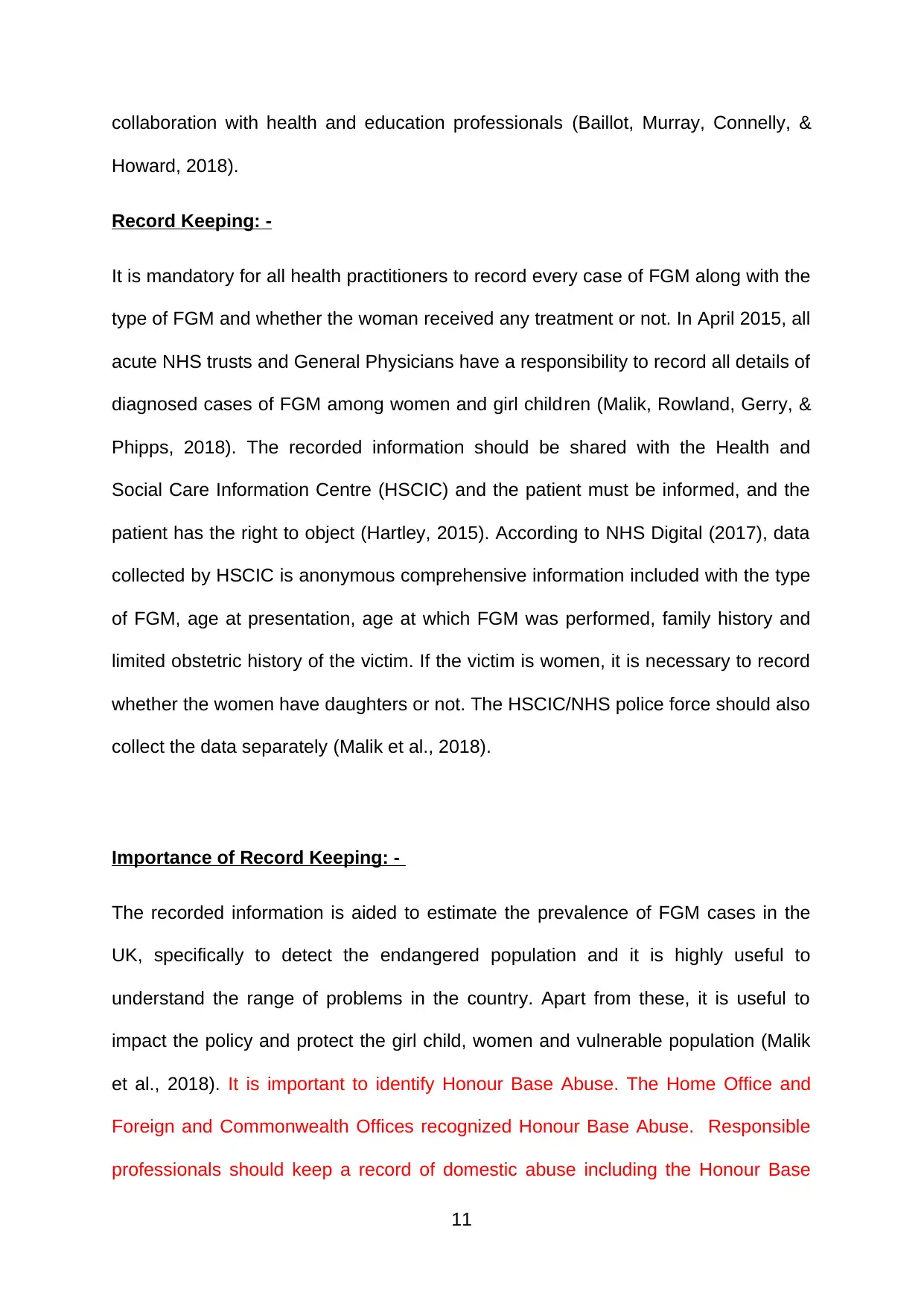
collaboration with health and education professionals (Baillot, Murray, Connelly, &
Howard, 2018).
Record Keeping: -
It is mandatory for all health practitioners to record every case of FGM along with the
type of FGM and whether the woman received any treatment or not. In April 2015, all
acute NHS trusts and General Physicians have a responsibility to record all details of
diagnosed cases of FGM among women and girl children (Malik, Rowland, Gerry, &
Phipps, 2018). The recorded information should be shared with the Health and
Social Care Information Centre (HSCIC) and the patient must be informed, and the
patient has the right to object (Hartley, 2015). According to NHS Digital (2017), data
collected by HSCIC is anonymous comprehensive information included with the type
of FGM, age at presentation, age at which FGM was performed, family history and
limited obstetric history of the victim. If the victim is women, it is necessary to record
whether the women have daughters or not. The HSCIC/NHS police force should also
collect the data separately (Malik et al., 2018).
Importance of Record Keeping: -
The recorded information is aided to estimate the prevalence of FGM cases in the
UK, specifically to detect the endangered population and it is highly useful to
understand the range of problems in the country. Apart from these, it is useful to
impact the policy and protect the girl child, women and vulnerable population (Malik
et al., 2018). It is important to identify Honour Base Abuse. The Home Office and
Foreign and Commonwealth Offices recognized Honour Base Abuse. Responsible
professionals should keep a record of domestic abuse including the Honour Base
11
Howard, 2018).
Record Keeping: -
It is mandatory for all health practitioners to record every case of FGM along with the
type of FGM and whether the woman received any treatment or not. In April 2015, all
acute NHS trusts and General Physicians have a responsibility to record all details of
diagnosed cases of FGM among women and girl children (Malik, Rowland, Gerry, &
Phipps, 2018). The recorded information should be shared with the Health and
Social Care Information Centre (HSCIC) and the patient must be informed, and the
patient has the right to object (Hartley, 2015). According to NHS Digital (2017), data
collected by HSCIC is anonymous comprehensive information included with the type
of FGM, age at presentation, age at which FGM was performed, family history and
limited obstetric history of the victim. If the victim is women, it is necessary to record
whether the women have daughters or not. The HSCIC/NHS police force should also
collect the data separately (Malik et al., 2018).
Importance of Record Keeping: -
The recorded information is aided to estimate the prevalence of FGM cases in the
UK, specifically to detect the endangered population and it is highly useful to
understand the range of problems in the country. Apart from these, it is useful to
impact the policy and protect the girl child, women and vulnerable population (Malik
et al., 2018). It is important to identify Honour Base Abuse. The Home Office and
Foreign and Commonwealth Offices recognized Honour Base Abuse. Responsible
professionals should keep a record of domestic abuse including the Honour Base
11
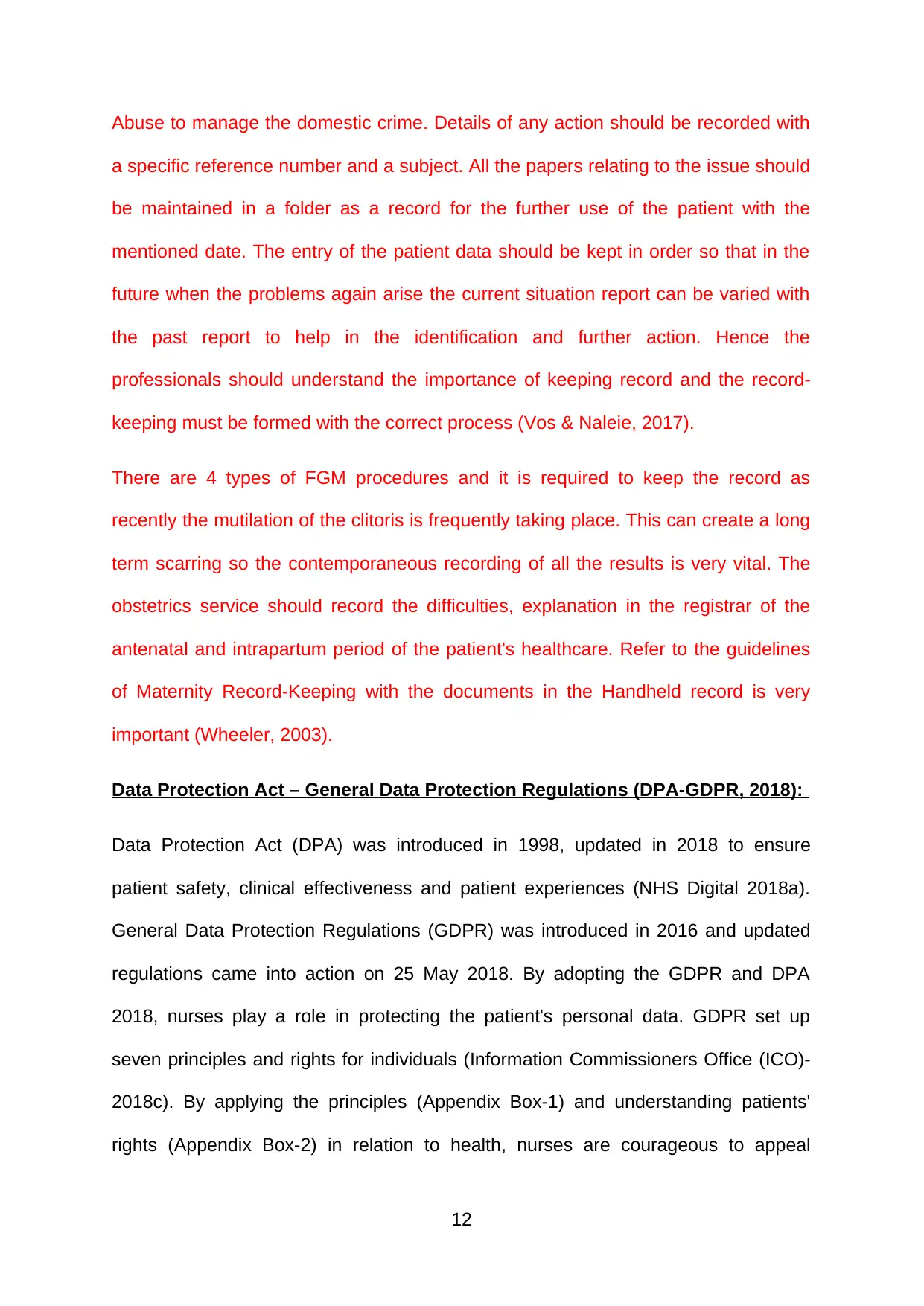
Abuse to manage the domestic crime. Details of any action should be recorded with
a specific reference number and a subject. All the papers relating to the issue should
be maintained in a folder as a record for the further use of the patient with the
mentioned date. The entry of the patient data should be kept in order so that in the
future when the problems again arise the current situation report can be varied with
the past report to help in the identification and further action. Hence the
professionals should understand the importance of keeping record and the record-
keeping must be formed with the correct process (Vos & Naleie, 2017).
There are 4 types of FGM procedures and it is required to keep the record as
recently the mutilation of the clitoris is frequently taking place. This can create a long
term scarring so the contemporaneous recording of all the results is very vital. The
obstetrics service should record the difficulties, explanation in the registrar of the
antenatal and intrapartum period of the patient's healthcare. Refer to the guidelines
of Maternity Record-Keeping with the documents in the Handheld record is very
important (Wheeler, 2003).
Data Protection Act – General Data Protection Regulations (DPA-GDPR, 2018):
Data Protection Act (DPA) was introduced in 1998, updated in 2018 to ensure
patient safety, clinical effectiveness and patient experiences (NHS Digital 2018a).
General Data Protection Regulations (GDPR) was introduced in 2016 and updated
regulations came into action on 25 May 2018. By adopting the GDPR and DPA
2018, nurses play a role in protecting the patient's personal data. GDPR set up
seven principles and rights for individuals (Information Commissioners Office (ICO)-
2018c). By applying the principles (Appendix Box-1) and understanding patients'
rights (Appendix Box-2) in relation to health, nurses are courageous to appeal
12
a specific reference number and a subject. All the papers relating to the issue should
be maintained in a folder as a record for the further use of the patient with the
mentioned date. The entry of the patient data should be kept in order so that in the
future when the problems again arise the current situation report can be varied with
the past report to help in the identification and further action. Hence the
professionals should understand the importance of keeping record and the record-
keeping must be formed with the correct process (Vos & Naleie, 2017).
There are 4 types of FGM procedures and it is required to keep the record as
recently the mutilation of the clitoris is frequently taking place. This can create a long
term scarring so the contemporaneous recording of all the results is very vital. The
obstetrics service should record the difficulties, explanation in the registrar of the
antenatal and intrapartum period of the patient's healthcare. Refer to the guidelines
of Maternity Record-Keeping with the documents in the Handheld record is very
important (Wheeler, 2003).
Data Protection Act – General Data Protection Regulations (DPA-GDPR, 2018):
Data Protection Act (DPA) was introduced in 1998, updated in 2018 to ensure
patient safety, clinical effectiveness and patient experiences (NHS Digital 2018a).
General Data Protection Regulations (GDPR) was introduced in 2016 and updated
regulations came into action on 25 May 2018. By adopting the GDPR and DPA
2018, nurses play a role in protecting the patient's personal data. GDPR set up
seven principles and rights for individuals (Information Commissioners Office (ICO)-
2018c). By applying the principles (Appendix Box-1) and understanding patients'
rights (Appendix Box-2) in relation to health, nurses are courageous to appeal
12
⊘ This is a preview!⊘
Do you want full access?
Subscribe today to unlock all pages.

Trusted by 1+ million students worldwide
1 out of 25
Related Documents
Your All-in-One AI-Powered Toolkit for Academic Success.
+13062052269
info@desklib.com
Available 24*7 on WhatsApp / Email
![[object Object]](/_next/static/media/star-bottom.7253800d.svg)
Unlock your academic potential
Copyright © 2020–2025 A2Z Services. All Rights Reserved. Developed and managed by ZUCOL.




